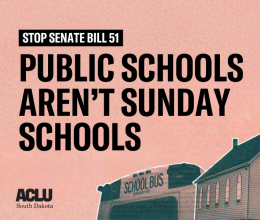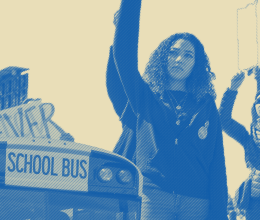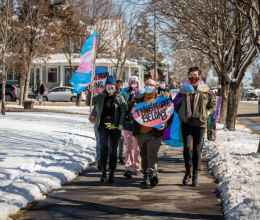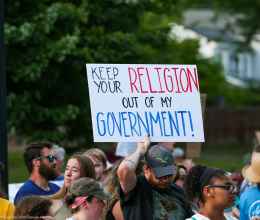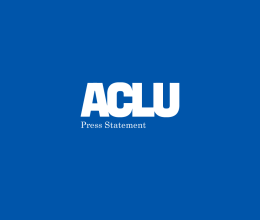
Here at the ACLU of South Dakota, we believe strongly in the protections of the First Amendment. Free speech and public debate are one of the core foundations of our country, and any legislation that attacks those rights is a bad move in our book. This morning I was prepared to testify in opposition to HB 1145, a bill that would have allowed the government to target speech arising out of “community organizing efforts.” I had my case citations at hand and my background research in my briefcase and was strangely looking forward to speaking. The bill, however, was withdrawn at the request of the sponsors this morning before a House committee hearing.
Because I didn’t get to actually give this testimony, I wanted to share it here on the blog so my fellow First Amendment nerds could enjoy it. See you on the other side of the 2017 legislative session!
Good morning, Mr. Chairman and members of the Committee. My name is Libby Skarin and I’m an attorney and the Policy Director for the ACLU of South Dakota. I’m here this morning to respectfully ask the committee to defeat this bill as it runs afoul of the First Amendment’s protections of free speech and protest in public spaces.
The Supreme Court has repeatedly held that the First Amendment reflects “a profound national commitment to the principle that debate on public issues should be uninhibited, robust, and wide-open.”[i] They’ve also held that speech on issues of public concern is entitled to special protection.[ii]
Any legislation regulating protest in public forum space—including public streets—will receive the highest scrutiny from the federal courts. This is so because it risks silencing speech in places where First Amendment rights are at their zenith. Public places like streets and sidewalks that are associated with protest and activism “are considered, without more, to be ‘public forums.’”[iii] As the Supreme Court has said, the government is “sharply circumscribed” in its authority to restrain expressive activity in “places which . . . have been devoted to assembly and debate.”
Based on this alone, legislation regulating protest activity in the streets will receive careful review from the courts. But House Bill 1145 contains an additional flaw: it singles out only certain assemblies that result from “community organizing efforts.”
Governments may, of course, reasonably regulate the time, place, and manner of public speech to ensure the operation of vital government facilities. What they may not do, however, is implement or create these regulations based on the content of the speech.
Per its own terms, this bill applies solely to assembly arising out of “community organizing efforts” and excludes from regulation those that are assembling for other purposes. This kind of distinction is “content-based,” which faces the strictest scrutiny from the courts.[iv]
Courts have repeatedly and consistently found that content-based laws are “‘presumptively invalid,’ and the government bears the burden to rebut that presumption.”[v] The burden the state must bear is to satisfy the most heightened level of scrutiny by the courts. This standard, called strict scrutiny, requires the state to demonstrate that the law in question advances a compelling government interest and is narrowly tailored to that interest.
While I recognize that a true public safety emergency should of course be addressed by authorities to keep people safe and allow access to immediately necessary government operations, doing so in a way that targets only the particular type of public nuisances that arise as a result of First Amendment activity is inappropriate.
Any bill attaching penalties to protest activities in public forum space must clear a high constitutional bar. Laws that reference a particular type of speech or activism—as this bill does—simply cannot meet that bar. We urge you to reject HB1145—because it is an unconstitutional violation of both the spirit and the letter of the First Amendment as applied to public spaces.
Thank you
[i][i] New York Times Co. v. Sullivan, 376 U.S. 254, 270 (1964).
[ii] Connick v. Myers, 461 U.S. 138, 145 (1983).
[iii] United States v. Grace, 461 U.S. 171, 177 (1983); see also Snyder, 131 S. Ct. at 1218 (noting that the Supreme Court has “repeatedly referred to public streets as the archetype of a traditional public forum”); Pleasant Grove City, Utah v. Summum, 555 U.S. 460, 469 (2009) (noting “government entities are strictly limited in their ability to regulate private speech” in “such ‘traditional public fora’” as public streets and parks); Frisby v. Schultz, 487 U.S. 474, 481 (1988) (finding that courts need not make any “particularized inquiry into the precise nature of a specific street” because “all public streets are held in the public trust and are properly considered traditional public fora”).
[iv] See, e.g. Carey v. Brown, 447 U.S. 455, 462, 470 (1980) (the government may enact time, place and manner restrictions to ensure the operation of vital government facilities, but not if “it is the content of the speech that determines whether it is within or without the statute’s blunt prohibition.”).
[v] Stevens, 559 U.S. at 468 (internal citations omitted); R.A.V. v. City of St. Paul, Minn., 505 U.S. 377, 382 (1992).

